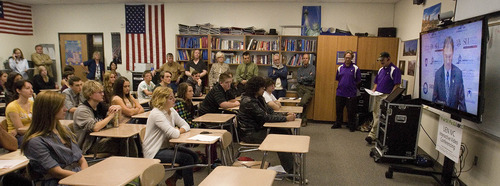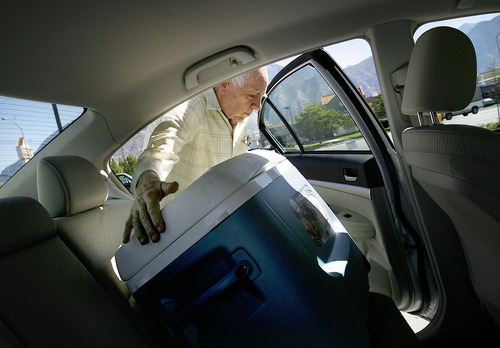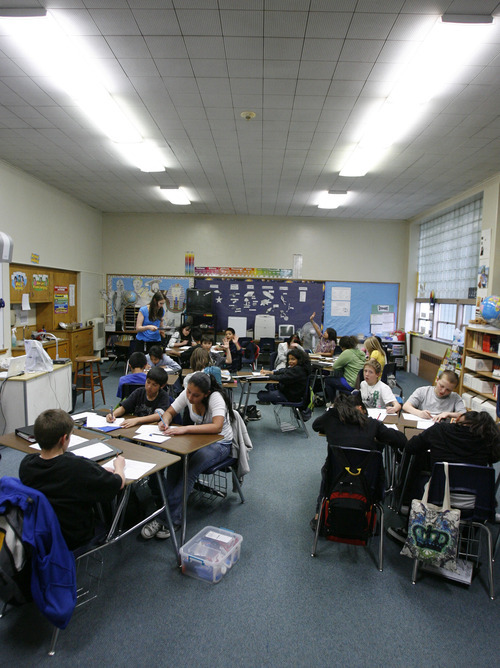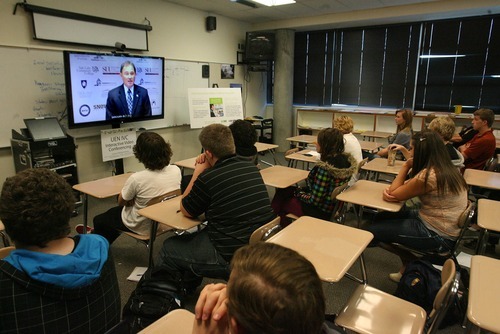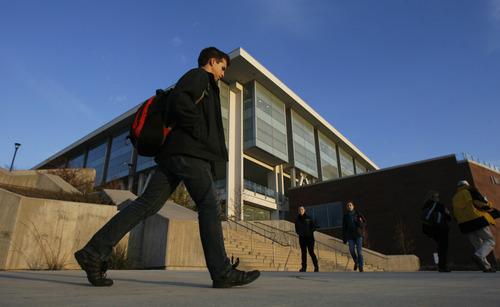This is an archived article that was published on sltrib.com in 2012, and information in the article may be outdated. It is provided only for personal research purposes and may not be reprinted.
After weeks of warm-up, lawmakers are getting down to the serious business of setting priorities for education, law enforcement and human services for the coming year.
The blueprint for state government is expected to come in at around $13 billion, with funding public education the top priority.
The final set of revenue projections will be announced Tuesday. Currently, lawmakers are expecting to have about $400 million in extra funding to build into their budget and have been meeting over the past several weeks to identify priorities.
"Everybody's pretty clear. We know about where the budget is," said House Speaker Becky Lockhart. "We know there's a little bit of increased revenue, but not a lot."
Additionally, legislators will look for ways to pay for increasing health care needs among Utah's poor, catching up on a building maintenance backlog and keeping criminals off the streets.
More contentious issues will develop over how much involvement the state should have in financing the Lake Powell Pipeline, whether to extend insurance coverage to children with autism and how to get the best results out of Utah's schools.
Lawmakers will have an added windfall of about $23 million to spend from a nationwide mortgage settlement. Gov. Gary Herbert has put forward a wish list for the funds that includes mortgage education programs, mortgage counseling and foreclosure prevention programs.
Robert Gehrke
Public Education • Utah schools will likely get more cash this session than they have in years — though exactly how much is still somewhat up in the air.
The Legislature's education budget committee has recommended an additional $146 million for schools next year.
That could include $36 million to fund nearly 12,500 additional students expected in Utah schools in the fall. It could also include $21 million to boost base per-pupil spending by 1 percent — though some lawmakers worry that will be swallowed up by nearly $25 million in expected retirement cost increases.
The committee also recommended paying for a number of items that state education leaders have tagged as their top priorities, including:
• $6.7 million to help implement computer-adaptive testing;
• $15 million to help pay for computers and other technology to give those tests;
• $700,000 to help implement college readiness tests like the ACT;
• $10 million for continued optional, extended-day kindergarten and other early childhood interventions.
Some other requested items, however, such as $8 million cut from programs for at-risk students last year, are not included in those recommendations.
"I think that those are difficult decisions, and I think the committee went through a reasonable process, and while I might not have ranked everything the way they did, I think that as it goes through the remainder of the session this will continue to be vetted," said state schools Superintendent Larry Shumway.
But other parts of the committee's process in making budget recommendations have received serious criticism. For example, the committee made a recommendation during a late-night meeting Wednesday to gradually shift part of the cost of charter schools to school districts.
The state school board sent a letter to legislative leaders asking them to set aside the committee's recommendations, alleging they violated the Open and Public Meetings Act. Ultimately, the Executive Appropriations Committee will decide what to put before the full Legislature when it comes to the education budget.
Lisa Schencker
Health • As usual, the lion's share of the health department's budget request goes to fund Medicaid — including projected growth, inflation for providers and other federal requirements.
Those requests make up $525 million of the priorities set by Social Services Appropriation Subcommittee. Another $8.4 million would fund the expansion of the Children's Health Insurance Program.
Rep. Daniel McCay, R-Riverton, tried to prioritize other, smaller programs above Medicaid, saying those programs likely won't get funding once Medicaid eats up the budget. "I don't think at the end of the day that Medicaid should trump all of our services," he said.
But the Medicaid program is federally mandated. And Sen. Patricia Jones, D-Holladay, retorted that the safety net program for children, the disabled and those on long-term care should not be vilified. "It's part of our responsibility to have respect for those who do take advantage of Medicaid."
The committee shot down attempts to prioritize millions of dollars for a pilot program to give early intervention to preschoolers with autism. But that decision likely will be overridden since House GOP leaders crafted the deal.
The Department of Health is also seeking $7.1 million to cover past and projected shortfalls in two tobacco accounts that pay for CHIP and for tobacco prevention programs. Recent increases in federal and state taxes have reduced the number of packs sold.
Other priorities include:
• Restoring dental, vision and audiology services to adults on Medicaid;
• Resuming funding for vaccines for underinsured children — those who don't qualify for Medicaid or CHIP and whose private insurance doesn't cover vaccines. Federal cuts required the state to stop offering the coverage this year;
• Boosting funding for public mental health centers to offset the state's anticipated move to a preferred drug list for certain mental health drugs for people on Medicaid.
Heather May
Higher education • Faculty and staff can expect their first pay increase in three years if recommendations by a legislative panel are enacted.
The 1 percent pay hike tops the recommendations for increases in ongoing funding, totalling $42.5 million, submitted by the budget committee overseeing this area. These hikes, which would cost $7.1 million, are not included in the governor's recommendations, which call for pay increases for everyone else employed in state government.
Other priorities for increased funding include, in descending order:
• $8 million to be allocated to the state's eight public colleges and universities under the new mission-based funding model;
• $7.4 million to address the backlog of students trying to get into high-demand programs at the Utah College of Applied Technology;
• $1.7 million for the merit-based Regents' Scholarship;
• $3 million to help Utah State University develop its regional campuses;
• $2.5 million for a statewide program to design and deliver standardized concurrent enrollment courses for high school students.
The panel also outlined more than $2 million in one-time infusions, most of which would go to the need-based program call Success Stipends. The No. 1 priority on the entire list is $500,000 to build a "college-readiness assessment tool," which is hoped to reduce the number of high school graduates requiring remedial coursework.
Another budget panel identified the U.'s utility upgrade as the state's top priority for capital projects, but it trimmed the request from $50 million to $38 million. Seven of the eight projects prioritized by the committee relate to higher education, including a new classroom building at Utah Valley University, a health science building at Southwest Applied Technology College and Weber State's new science lab building.
Brian Maffly
Corrections and public safety • Parole violators would have a separate prison facility, and experienced Utah Highway Patrol troopers would get pay raises based on seniority if the budget committee overseeing the agencies has its priorities approved.
Members of the Executive Offices and Criminal Justice budget committee placed those two funding needs at the top of their list.
Also high priorities: giving county jails more money to house additional low-security state prisoners, and allotting money to the state crime lab to hire an additional spice specialist with the goal of speeding up turnaround time on evidence for criminal cases.
The lab also would get $100,000 to increase the pay of its firearms specialist, one of the few in the country.
The committee didn't fund either agency for some of their biggest requests, instead directing them to use money they saved elsewhere for new programs.
"It's not ideal, but it's in line with the governor's recommendation," said Tom Patterson, executive director of the Department of Corrections.
In other funding recommendations:
• Youth Services would receive $2.5 million to keep rural centers open where ungovernable children can be dropped off, which frees up police to patrol the streets rather than wait for a responsible adult to pick up the child.
• The Weber Detention Center should be able to keep its doors open for at least one more year.
• A work camp where youth offenders can work off debts they owe victims would be able to remain open.
Utahns may see additional troopers on the highways, and the Attorney General's Office could have more prosecutors and law enforcement officers to prosecute the worst crimes committed by undocumented immigrants.
Sheena McFarland
Human services • The Social Services Appropriations Committee had its eye on current and coming cuts in federal funding — and a philosophical interest in less dependence on the federal government — as it put together the Department of Human Services's budget for next year, pegged at $557 million.
The wish list of services for people with disabilities favors nearly $9.4 million to correct imbalances in Medicaid waivers, which would include helping youths with intellectual disabilities who are aging out of programs for children and pay for required federal mandates.
Another spending priority would be $78,000 for a job-placement specialist fluent in American Sign Language to help deaf people find jobs, a critical need in a community seeing unemployment rates of up to 70 percent. Other assistance for deaf and blind people who need help with activities such as reading mail or newspapers, grocery shopping, transportation and other daily activities could get a $50,000 infusion.
A rise in elder abuse in Utah prompted a request for $206,000 to add three positions to the Adult Protective Services staff to handle the increased case load. But a $2.5 million appropriation to whittle the waiting list for disabled services and $500,000 to bolster the Department of Human Services' contribution to senior nutrition and Meals on Wheels appear to be in jeopardy.
Overall, the Division of Child and Family Services will stay flat — at $156 million, plus $6 million in one-time funds — if the proposed budget stays intact. Some of the one-time money would be devoted to increasing in-home services so fewer children spend time in foster care. None of the Division of Child and Family Services' new funding requests made it into the top 20 on the committee's prioritization list at this point.
DCFS wants an extra $120,300 to help reverse trims in foster care rates. The hourly rate for basic foster care currently ranges from $14 to $16, depending on the age of the child; that's a dollar less than four years ago.
Patty Henetz and Brooke Adams



